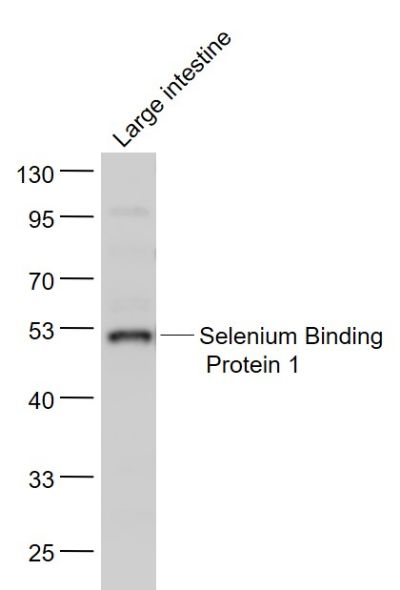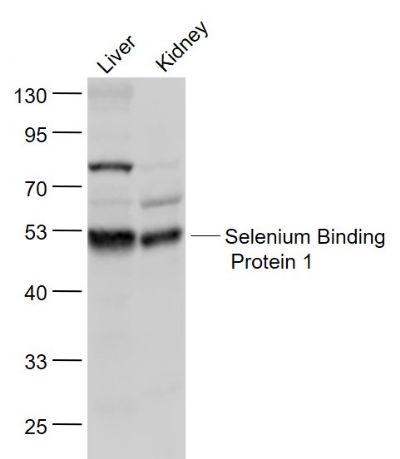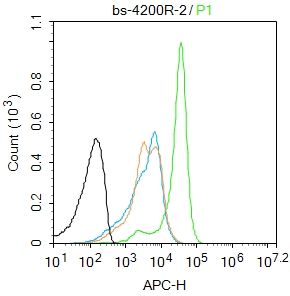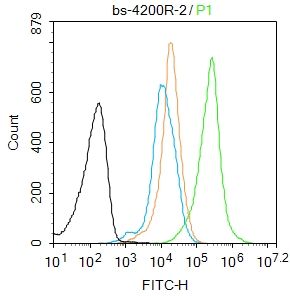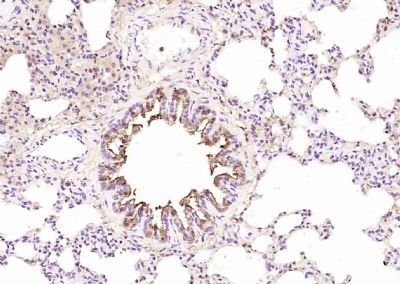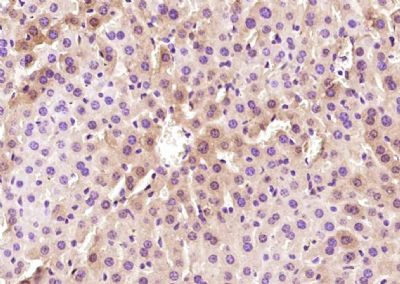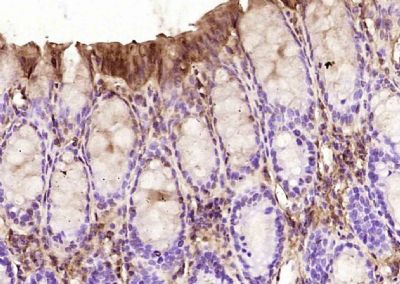Selenium Binding Protein 1 Polyclonal Antibody
Purified Rabbit Polyclonal Antibody (Pab)
- SPECIFICATION
- CITATIONS
- PROTOCOLS
- BACKGROUND

Application
| WB, IHC-P, IHC-F, IF, ICC, E |
|---|---|
| Primary Accession | Q13228 |
| Reactivity | Rat, Dog, Bovine |
| Host | Rabbit |
| Clonality | Polyclonal |
| Calculated MW | 52 KDa |
| Physical State | Liquid |
| Immunogen | KLH conjugated synthetic peptide derived from human SBP1/Selenium Binding Protein 1 |
| Epitope Specificity | 401-472/472 |
| Isotype | IgG |
| Purity | affinity purified by Protein A |
| Buffer | 0.01M TBS (pH7.4) with 1% BSA, 0.02% Proclin300 and 50% Glycerol. |
| SUBCELLULAR LOCATION | Nucleus. Cytoplasm, cytosol. Membrane; Peripheral membrane protein. Note=May associate with Golgi membrane. May associate with the membrane of autophagosomes. |
| SIMILARITY | Belongs to the selenium-binding protein family. |
| SUBUNIT | Interacts with USP33. |
| Post-translational modifications | The N-terminus is blocked. |
| Important Note | This product as supplied is intended for research use only, not for use in human, therapeutic or diagnostic applications. |
| Background Descriptions | Selenium is an essential trace element that confers tolerance to toxicity arising through exposure to heavy metals or other reactive xenobiotics. Selenium exhibits potent anticarcinogenic properties, and deficiency of selenium may cause certain neurologic diseases. Both effects are attributed to selenium-binding proteins. Selenium binding protein 1 is down-regulated in lung adenocarcinoma, colorectal cander and ovarian cancer. It is two-fold upregulated in the brains of patients suffering from schizophrenia, and is therefore a biomarker for this disease. |
| Gene ID | 8991 |
|---|---|
| Other Names | Methanethiol oxidase, MTO, 1.8.3.4, 56 kDa selenium-binding protein, SBP56, SP56, Selenium-binding protein 1, SELENBP1, SBP |
| Target/Specificity | Present in liver and colon (at protein level). |
| Dilution | WB=1:500-2000,IHC-P=1:100-500,IHC-F=1:100-500,ICC=1:100-500,IF=1:100-500,Flow-Cyt=2ug/Test,ELISA=1:5000-10000 |
| Storage | Store at -20 ℃ for one year. Avoid repeated freeze/thaw cycles. When reconstituted in sterile pH 7.4 0.01M PBS or diluent of antibody the antibody is stable for at least two weeks at 2-4 ℃. |
| Name | SELENBP1 |
|---|---|
| Synonyms | SBP |
| Function | Catalyzes the oxidation of methanethiol, an organosulfur compound known to be produced in substantial amounts by gut bacteria (PubMed:29255262). Selenium-binding protein which may be involved in the sensing of reactive xenobiotics in the cytoplasm. May be involved in intra-Golgi protein transport (By similarity). |
| Cellular Location | Nucleus. Cytoplasm, cytosol Membrane {ECO:0000250|UniProtKB:Q8VIF7}; Peripheral membrane protein {ECO:0000250|UniProtKB:Q8VIF7}. Note=May associate with Golgi membrane (By similarity). May associate with the membrane of autophagosomes (By similarity). {ECO:0000250|UniProtKB:Q8VIF7} |
| Tissue Location | Widely expressed. Highly expressed in liver, lung, colon, prostate, kidney and pancreas. In brain, present both in neurons and glia (at protein level). Down-regulated in lung adenocarcinoma, colorectal carcinoma and ovarian cancer. Two-fold up-regulated in brain and blood from schizophrenia patients. |

Thousands of laboratories across the world have published research that depended on the performance of antibodies from Abcepta to advance their research. Check out links to articles that cite our products in major peer-reviewed journals, organized by research category.
info@abcepta.com, and receive a free "I Love Antibodies" mug.
Provided below are standard protocols that you may find useful for product applications.
If you have used an Abcepta product and would like to share how it has performed, please click on the "Submit Review" button and provide the requested information. Our staff will examine and post your review and contact you if needed.
If you have any additional inquiries please email technical services at tech@abcepta.com.













 Foundational characteristics of cancer include proliferation, angiogenesis, migration, evasion of apoptosis, and cellular immortality. Find key markers for these cellular processes and antibodies to detect them.
Foundational characteristics of cancer include proliferation, angiogenesis, migration, evasion of apoptosis, and cellular immortality. Find key markers for these cellular processes and antibodies to detect them. The SUMOplot™ Analysis Program predicts and scores sumoylation sites in your protein. SUMOylation is a post-translational modification involved in various cellular processes, such as nuclear-cytosolic transport, transcriptional regulation, apoptosis, protein stability, response to stress, and progression through the cell cycle.
The SUMOplot™ Analysis Program predicts and scores sumoylation sites in your protein. SUMOylation is a post-translational modification involved in various cellular processes, such as nuclear-cytosolic transport, transcriptional regulation, apoptosis, protein stability, response to stress, and progression through the cell cycle. The Autophagy Receptor Motif Plotter predicts and scores autophagy receptor binding sites in your protein. Identifying proteins connected to this pathway is critical to understanding the role of autophagy in physiological as well as pathological processes such as development, differentiation, neurodegenerative diseases, stress, infection, and cancer.
The Autophagy Receptor Motif Plotter predicts and scores autophagy receptor binding sites in your protein. Identifying proteins connected to this pathway is critical to understanding the role of autophagy in physiological as well as pathological processes such as development, differentiation, neurodegenerative diseases, stress, infection, and cancer.
